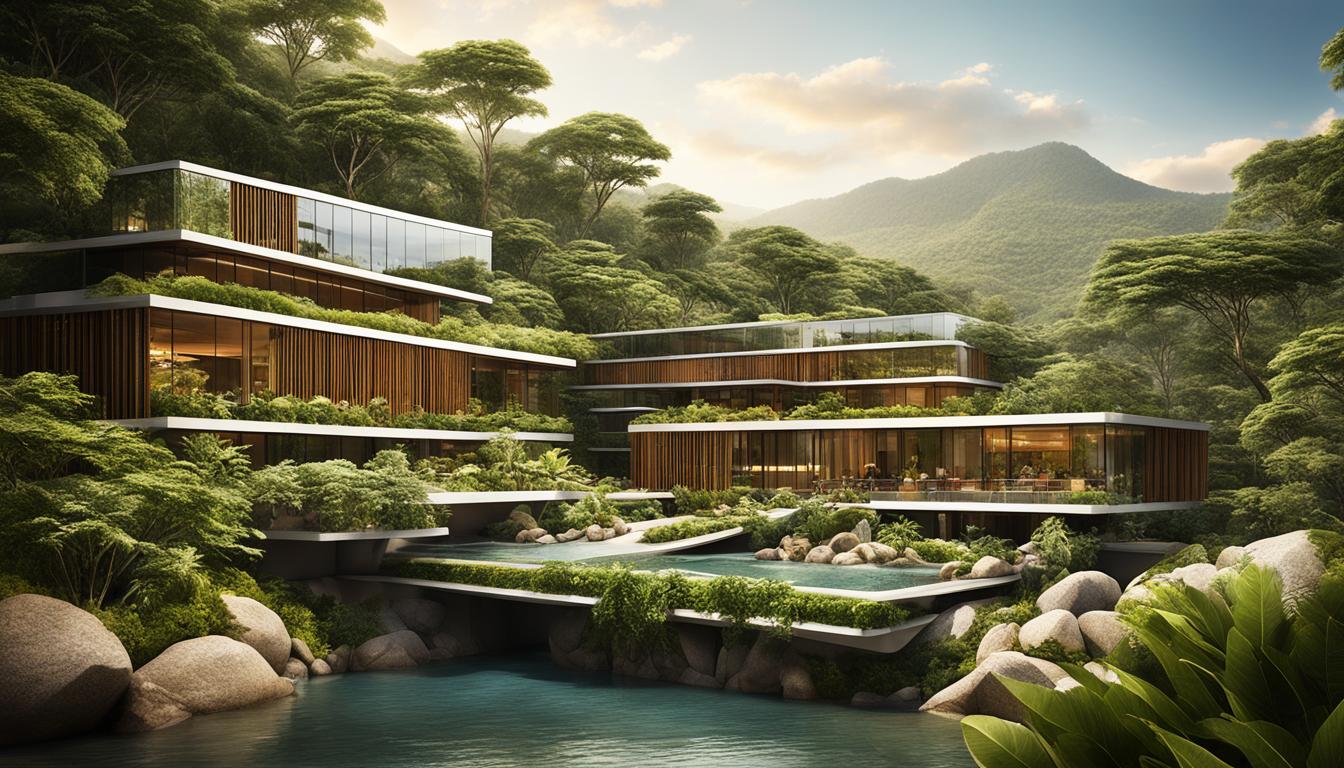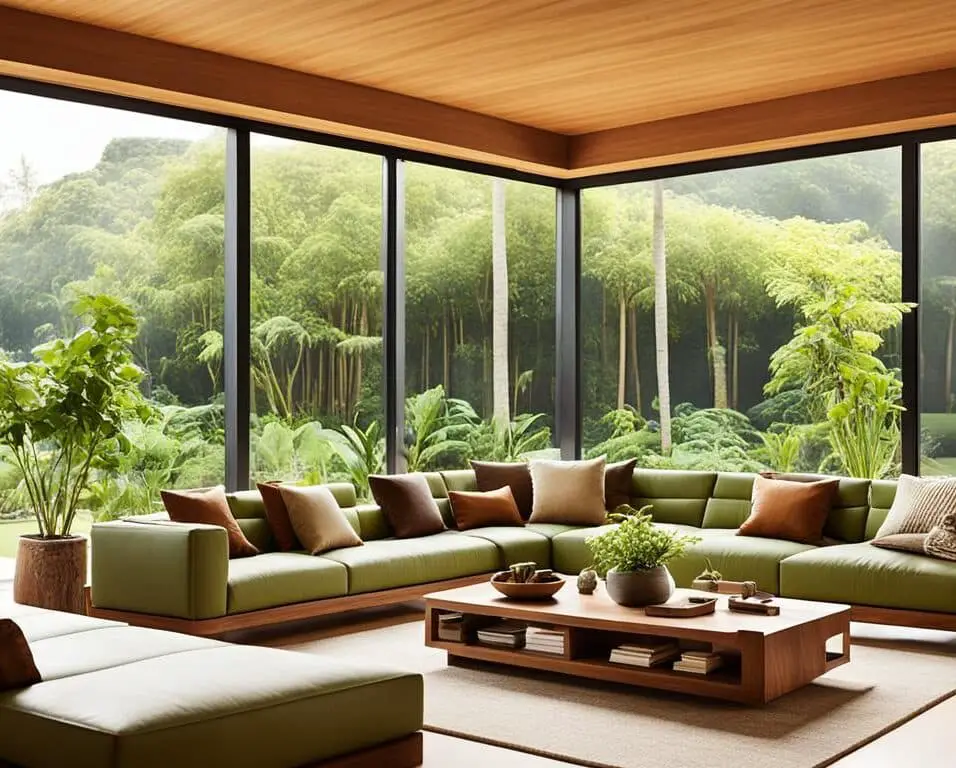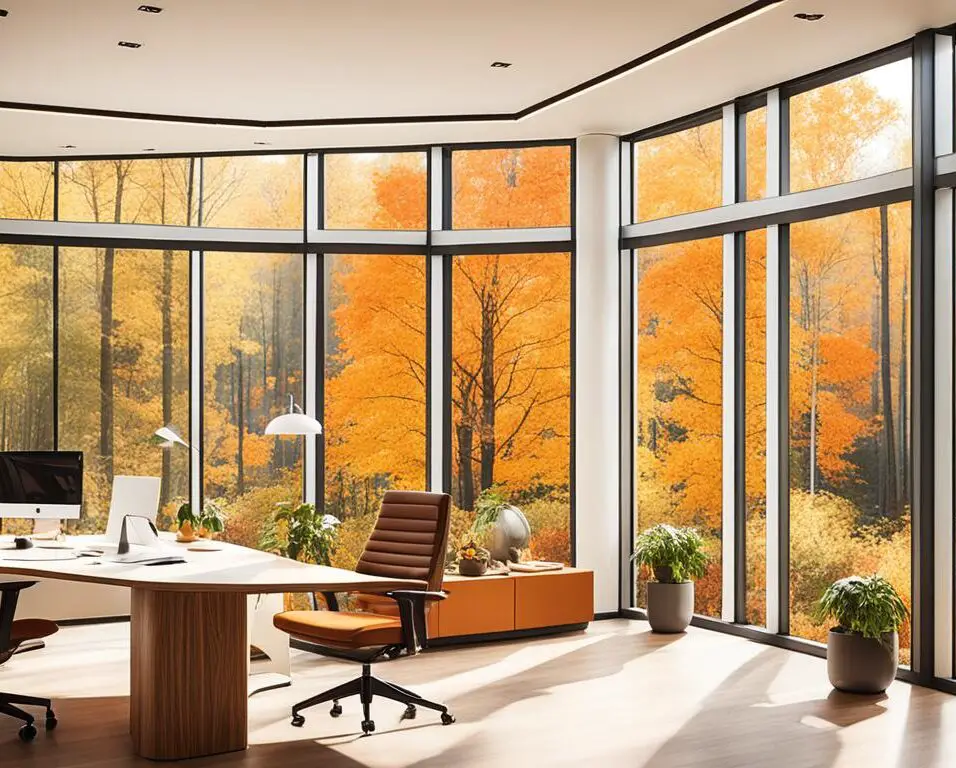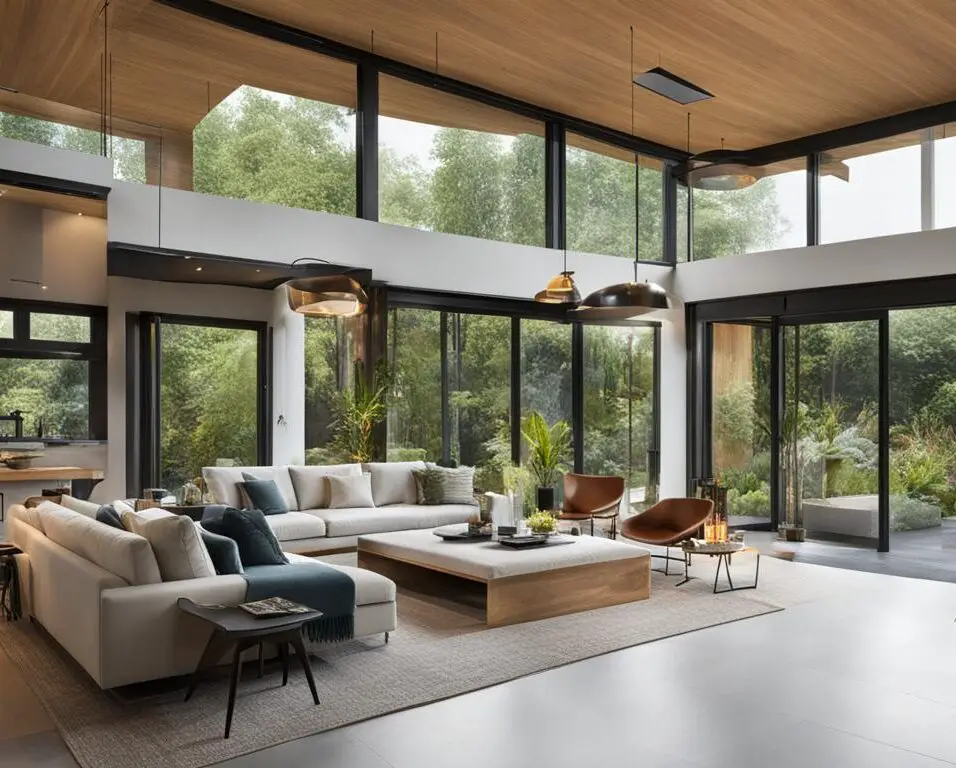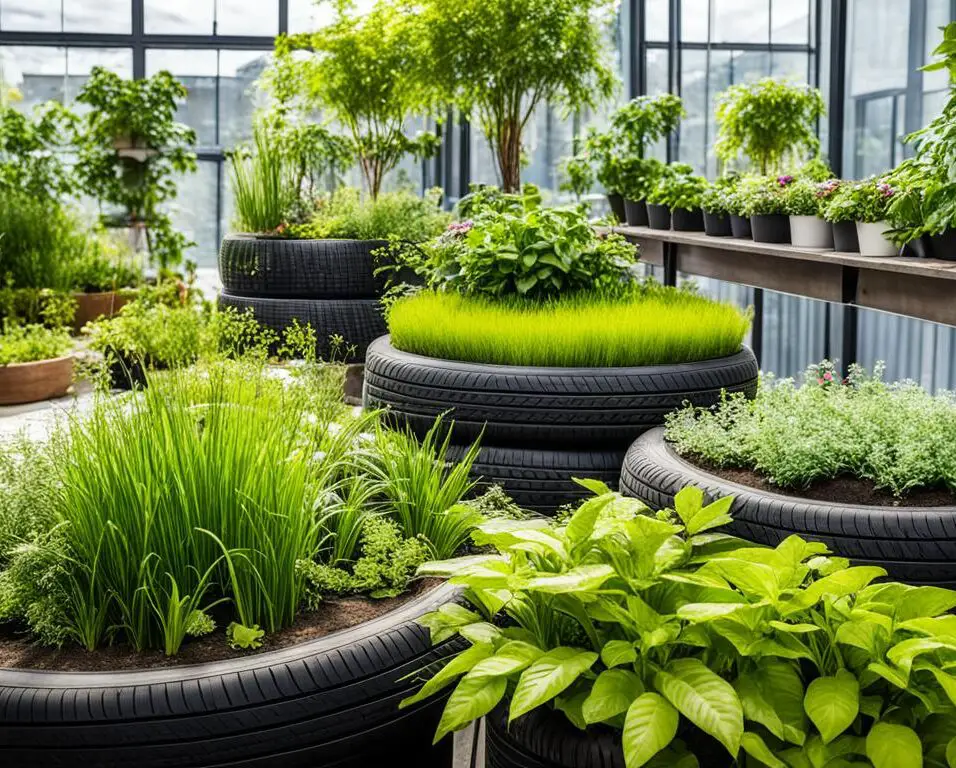Harmonizing Nature and Structure: Incorporating Natural Elements into Modern Architecture
Incorporating natural elements into modern architecture is a design approach that combines the beauty of nature with the functionality and innovation of contemporary design. By seamlessly blending natural materials, such as glass, wood, and stone, with modern construction techniques, architects and designers can create sustainable and visually appealing structures. This article explores the various ways in which natural elements are incorporated into modern architecture to achieve both environmental sustainability and aesthetic harmony.
Key Takeaways:
- Incorporating natural elements into modern architecture creates a harmonious connection between the built environment and nature.
- Using materials like glass, wood, and stone can add visual appeal and sustainability to modern structures.
- Natural light, transparent boundaries, and visual connections with the outdoors can be achieved through the use of glass in garden design.
- Art Deco influences, with bold lines and geometric patterns, can bring elegance and sophistication to modern house design.
- Sustainable design in modern architecture focuses on energy efficiency and the use of eco-friendly materials to reduce environmental impact.
The Versatility of Glass in Garden Design
Glass is a versatile material that has revolutionized contemporary garden design, offering boundless possibilities to create visually stunning and functional outdoor spaces. Its transparent nature allows for seamless integration with the surrounding landscape, blurring the boundaries between indoor and outdoor areas. By harnessing the properties of glass, garden designers can enhance the visual connection with nature, maximize natural light, and add a touch of elegance to any garden.
Transparent Boundaries and Visual Connection
One of the most significant advantages of incorporating glass into garden design is the ability to create transparent boundaries. Glass walls, windows, and partitions offer unobstructed views of the garden, providing a sense of openness and continuity. This visual connection with nature allows the garden to be enjoyed from both inside and outside the house, fostering a harmonious relationship between the built environment and the natural world.
Natural Light and Functional Purposes
Glass is a conduit for natural light, and strategically placed glass elements can optimize the amount of sunlight that enters a garden. Sunlight is essential for the growth and vitality of plants, making glass an invaluable tool for horticultural enthusiasts. Glass can also serve functional purposes in garden design. From greenhouse structures that enable year-round cultivation to conservatories that provide a tranquil space for relaxation, glass offers practical solutions while maintaining a strong aesthetic appeal.
Aesthetic Enhancements and Artistic Expressions
Glass has the power to elevate the aesthetic appeal of any garden. Sculptures, statues, and ornaments made of glass can add a captivating artistic dimension, creating focal points and enhancing the overall design. Additionally, the innovative use of bent glass allows for the creation of unique, curved structures that become eye-catching architectural features within the garden landscape. Whether it’s a mesmerizing glass water feature or a stunning glass gazebo, the creative possibilities with glass are endless.
“Glass is a versatile material that blurs the boundaries between indoor and outdoor spaces, creates stunning visual effects, and serves functional purposes in garden design.”
| Benefits of Glass in Garden Design | |
|---|---|
| Transparent boundaries | Unobstructed views of the garden |
| Visual connection | Seamless integration with nature |
| Natural light | Optimized sunlight for plants |
| Functional purposes | Greenhouses, conservatories, and more |
| Aesthetic enhancements | Glass sculptures and artistic expressions |
By embracing the versatility of glass, garden designers can transform ordinary spaces into extraordinary havens of tranquility and beauty. The seamless integration of glass in garden design not only enhances the aesthetic appeal but also strengthens the connection between humans and nature. With its transparent boundaries, ability to let in natural light, and functionality for various purposes, glass is an indispensable tool for creating breathtaking outdoor spaces that inspire and delight.
The Art Deco Influence in Modern House Design
Art Deco is not limited to the past. In fact, its influence can be seen in various aspects of modern house design. This iconic design style from the early 20th century has made a comeback, with its bold lines, geometric patterns, and luxurious materials capturing the attention of homeowners and designers alike.
When it comes to modern house design, incorporating art deco-inspired elements can create a sleek and stylish look that exudes elegance and sophistication. From the exterior to the interior, art deco can transform a house into a glamorous living space that is both timeless and visually appealing.
One of the key characteristics of art deco is bold lines, which can be incorporated into the architectural structure of a modern house. Whether it’s through the use of curved walls or angular facades, these bold lines create a sense of movement and dynamism.
Geometric patterns are another hallmark of art deco that can be integrated into modern house design. From intricate tiled floors to geometrically shaped furniture and accessories, these patterns add visual interest and a touch of glamour to the space.
Light fixtures play a crucial role in art deco-inspired modern house design. Sleek and geometrically shaped lighting fixtures, such as chandeliers and sconces, can become statement pieces that elevate the overall aesthetic of the space. They not only provide functional lighting but also serve as decorative elements that enhance the art deco vibe.
When it comes to luxury materials, art deco embraces the use of opulent and glamorous materials. Incorporating elements such as marble counters, polished brass fixtures, and richly textured fabrics can add a sense of luxury and refinement to a modern house.
Here is an example of how art deco influences modern house design:
| Art Deco Influences in Modern House Design | Art Deco Elements |
|---|---|
| Exterior Design | Bold lines and geometric shapes in the architectural structure |
| Interior Design | Geometric patterns in flooring, furniture, and accessories |
| Lighting | Sleek and geometrically shaped light fixtures |
| Materials | Luxury materials such as marble, brass, and richly textured fabrics |
The art deco influence in modern house design is a testament to the timelessness and versatility of this iconic design style. By incorporating bold lines, geometric patterns, and luxury materials, homeowners can create a modern living space that pays homage to the glamour and sophistication of the art deco era.
Sustainable Design in Modern Architecture
In modern architecture, sustainable design plays a crucial role in creating homes that are not only visually appealing but also environmentally conscious. By incorporating energy-efficient appliances, eco-friendly materials, and advanced fixtures, architects can design houses that prioritize energy efficiency and minimize the negative impact on the environment.
One of the key aspects of sustainable design in modern architecture is the use of energy-efficient appliances. From refrigerators to air conditioning systems, choosing energy-efficient options can significantly reduce the overall energy consumption of a home. These appliances are designed to maximize performance while minimizing energy usage, contributing to a more sustainable lifestyle.
In addition to energy-efficient appliances, the choice of materials is another important factor in sustainable design. Opting for eco-friendly materials such as reclaimed wood, recycled materials, and low-impact composites not only reduces the demand for new resources but also minimizes the amount of waste generated during construction. These materials ensure that the design process is environmentally responsible from start to finish.
| Eco-friendly Materials | Advantages |
|---|---|
| Bamboo flooring | Renewable, durable, and hypoallergenic |
| Recycled glass countertops | Stylish, heat-resistant, and made from recycled materials |
| Cork insulation | Energy-efficient, non-toxic, and renewable |
Furthermore, the use of low-VOC (volatile organic compounds) paints is another sustainable design choice that reduces the emission of harmful chemicals into the air. Low-VOC paints are not only better for the environment but also for the health of the occupants, as they significantly reduce indoor air pollution.
LED lighting is another important element of sustainable design in modern architecture. LED lights are highly energy-efficient, consuming significantly less energy than traditional incandescent bulbs. They also have a longer lifespan, reducing the frequency of replacements and further minimizing waste.
By incorporating these sustainable design principles into modern architecture, architects and designers can create homes that are not only visually stunning but also eco-friendly and energy-efficient. From energy-saving appliances to eco-friendly materials and low-VOC paints, each element contributes to a more sustainable future.
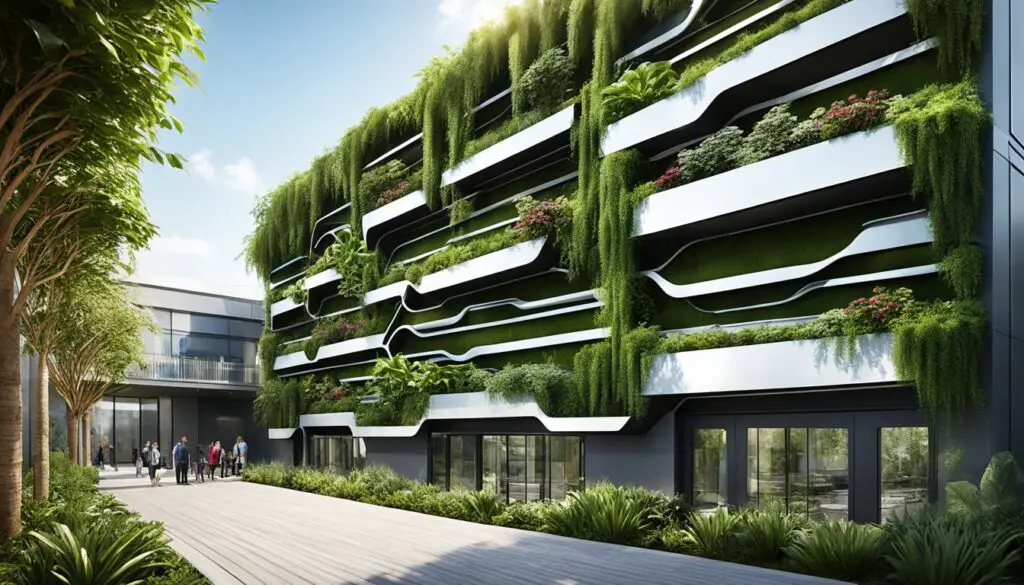
Small House Designs with Art Deco Touches
When it comes to small house designs, incorporating art deco touches can bring a unique and stylish aesthetic to the space. By combining the charm of art deco with the practicality of small space living, homeowners can create a visually appealing and functional home. From geometric patterns to brass fixtures, these art deco elements add character and depth to small spaces.
One way to introduce art deco touches is through the use of geometric patterns. Whether it’s on wallpaper, tiles, or textiles, geometric patterns can instantly transform a small space into a visually striking area. The bold lines and symmetry of art deco patterns create a sense of order and sophistication.
Another way to incorporate art deco into small house designs is through the use of brass fixtures. From faucets to lighting fixtures, brass adds a touch of elegance and luxury to any space. The warm tones of brass complement the geometric patterns and create a cohesive and stylish look.
To add a sense of depth and uniqueness to a small house, consider utilizing larger art deco-style furniture pieces. From sofas with clean lines to statement chairs, these pieces can become the focal point of the room. Pair them with patterned rugs and mirrors to create a visually appealing and dynamic space.
Lastly, maximizing the use of limited space is crucial in small house designs. By incorporating space-saving features, such as floating shelves and built-in storage, homeowners can optimize their living space while still maintaining the art deco aesthetic. These practical solutions combine functionality with style.
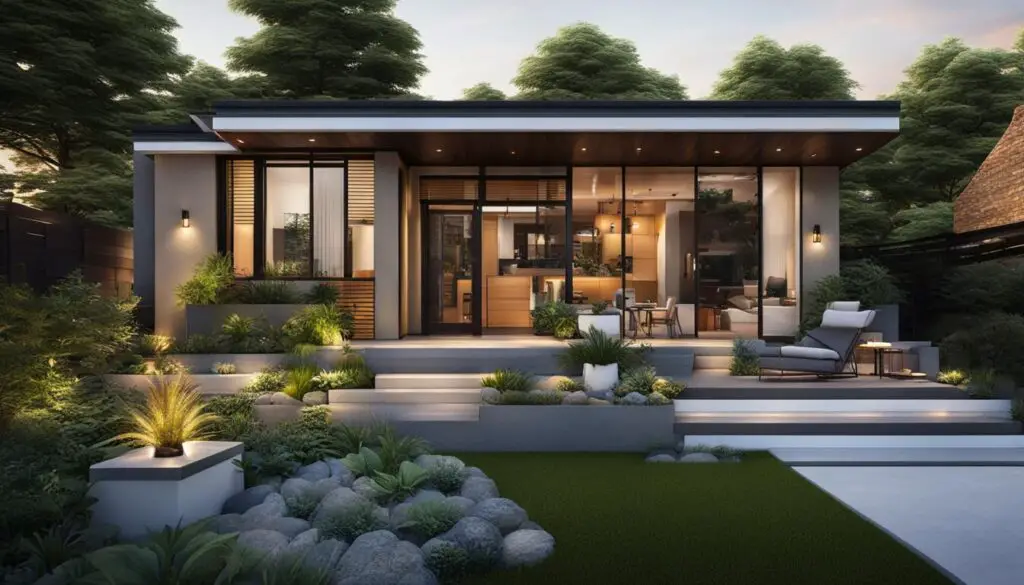
By incorporating art deco touches, small house designs can attain a unique and stylish look. Geometric patterns, brass fixtures, and space-saving features bring character and functionality to limited spaces. The fusion of art deco aesthetics with small house design principles creates a harmonious living space that is filled with personality and style.
| Key Elements of Small House Designs with Art Deco Touches | Features |
|---|---|
| Geometric Patterns | Wallpaper, tiles, textiles |
| Brass Fixtures | Faucets, lighting fixtures |
| Larger Art Deco-Style Furniture | Sofas, chairs |
| Patterned Rugs and Mirrors | Visual depth and uniqueness |
| Space-Saving Features | Floating shelves, built-in storage |
The Timelessness of Craftsman House Designs
Craftsman house designs perfectly balance classic, timeless elements with modern influences, creating a harmonious and inviting living space. By incorporating natural materials, traditional elements, and art deco accents, Craftsman-style homes offer a unique blend of old-world charm and contemporary flair.
One of the defining features of Craftsman house designs is the extensive use of natural materials. Wood, stone, and brick are commonly utilized to create a warm and inviting atmosphere. These natural materials not only lend a sense of authenticity to the design but also provide durability and sustainability.
Art deco accents introduce a touch of modernity to Craftsman house designs. Strategically placed wall art, stylish light fixtures, and elegant furniture with art deco-inspired features bring a contemporary flair to the overall design. The combination of traditional and art deco elements adds visual interest and creates a striking contrast that enhances the timeless appeal of the home.
Traditional Elements in Craftsman House Designs
Traditional elements play a crucial role in the design of Craftsman-style homes. The use of exposed wooden beams, intricate woodwork, and handcrafted details adds character and authenticity to the space. These traditional elements serve as a tribute to the craftsmanship of bygone eras, bringing a sense of history and heritage to the home.
Another notable aspect of Craftsman house designs is the emphasis on functionality. Built-in storage solutions, such as bookcases and window seats, maximize space utilization and provide practicality without compromising on aesthetics. The thoughtful integration of traditional elements with modern conveniences creates a harmonious balance between form and function.
Aesthetic Appeal of Craftsman House Designs
Craftsman house designs are admired for their timeless beauty. The attention to detail, quality craftsmanship, and use of natural materials contribute to the overall aesthetic appeal of these homes. The combination of warm earthy tones, inviting porches, and carefully designed landscaping creates a welcoming and visually pleasing facade.
Furthermore, Craftsman house designs often feature well-defined architectural details, such as tapered columns, exposed rafters, and decorative trims. These details add depth and dimension to the overall design, enhancing its visual impact and creating a sense of architectural integrity.
Incorporating natural materials, traditional elements, and art deco accents, Craftsman house designs offer a timeless charm that combines the best of both worlds. The seamless integration of classic and contemporary elements results in homes that are not only visually appealing but also functional and sustainable.
| Natural Materials | Traditional Elements | Art Deco Accents |
|---|---|---|
| Wood | Exposed wooden beams | Wall art |
| Stone | Intricate woodwork | Light fixtures |
| Brick | Handcrafted details | Furniture |
Minimalist House Designs with an Art Deco Influence
When it comes to minimalist house designs, simplicity and functionality are at the forefront. This design style embraces clean lines, neutral colors, and geometric shapes to create a sleek and modern look. Taking inspiration from the art deco movement, minimalist houses infuse a touch of glamour and sophistication into their minimalist aesthetic.
Utilizing natural materials like wood and stone adds warmth and texture to the minimalist design, while also creating a strong connection with nature. These materials contribute to the overall visual appeal of the space and maintain a sense of earthiness.
Incorporating modern appliances and fixtures is essential in minimalist house designs. These elements not only enhance the functionality of the space but also add a sense of luxury. Sleek and minimalist furniture pieces, chosen for their comfort and functionality, complete the overall aesthetic of a minimalist house.
“Simplicity is the ultimate sophistication.” – Leonardo da Vinci
The Key Elements of Minimalist House Designs with an Art Deco Influence
- Simplistic lines: Clean and streamlined designs with minimal embellishments.
- Neutral colors: Subdued tones like white, gray, beige, and black create a calming and timeless atmosphere.
- Geometric shapes: Emphasis on angular and symmetrical shapes adds visual interest and aesthetic appeal.
- Modern appliances: Incorporating state-of-the-art appliances complements the minimalist design and enhances functionality.
A minimalist house infused with an art deco influence offers the perfect blend of simplicity and elegance. The art deco touch adds a touch of glamour and sophistication, elevating the overall look and feel. By paying attention to the key elements of minimalist design with an art deco influence, homeowners can create a space that is both visually stunning and highly functional.
| Minimalist House Design Features | Art Deco Influence |
|---|---|
| Clean lines and simple shapes | Geometric patterns and bold lines |
| Neutral color palette | Luxurious materials and accents |
| Minimized clutter and open space | Ornate light fixtures and decorative elements |
| Focus on functionality and practicality | Artistic touches and unique design elements |
By combining the simplicity of minimalist house designs with the elegance of art deco influences, homeowners can achieve a space that is both visually appealing and highly functional. The clean lines, neutral colors, and geometric shapes create a minimalistic aesthetic, while the art deco influences add a touch of sophistication. With modern appliances and fixtures, minimalist houses with an art deco influence offer a seamless blend of simplicity, functionality, and style.
Conclusion
Incorporating natural elements into modern architecture is not only a design choice, but also an important step towards creating sustainable and visually appealing structures. By seamlessly blending natural materials with contemporary construction techniques, architects and designers can achieve both environmental sustainability and aesthetic harmony in their designs. Whether it’s using glass to create transparent boundaries between indoor and outdoor spaces, incorporating art deco touches into modern house designs, or adopting sustainable practices, the possibilities for incorporating natural elements into modern architecture are limitless.
By embracing these design principles, we can create a fusion of nature and structure that enhances our living spaces and provides a sense of harmony between the built environment and the natural world. The use of eco-friendly materials, energy-efficient technologies, and thoughtful design choices not only benefit the environment, but also contribute to the overall well-being of the occupants. The result is a home that not only looks beautiful, but also promotes a sustainable and healthy lifestyle.
As we continue to explore new ways to incorporate natural elements into modern architecture, the importance of sustainable design and aesthetic harmony will remain at the forefront. By prioritizing the integration of nature into our built environment, we can create spaces that are not only visually stunning, but also respectful of the world around us. So let us embrace the beauty of natural elements, push the boundaries of modern architecture, and create a future where sustainable design and aesthetic harmony go hand in hand.
FAQ
How can natural elements be incorporated into modern architecture?
Natural elements can be incorporated into modern architecture by seamlessly blending materials like glass, wood, and stone with modern construction techniques.
What are some uses of glass in garden design?
Glass in garden design can be used to blur the boundaries between indoor and outdoor spaces, create stunning visual effects, and serve functional purposes like providing unobstructed views of the garden.
How can art deco influence modern house design?
Art deco can influence modern house design through the use of bold lines, geometric patterns, luxury materials, and art deco-inspired elements like stainless steel kitchens and marble counters.
What is sustainable design in modern architecture?
Sustainable design in modern architecture involves incorporating energy-efficient appliances, eco-friendly materials, and state-of-the-art fixtures to create homes that are both aesthetically pleasing and mindful of the environment.
How can art deco touches be incorporated into small house designs?
Art deco touches can be incorporated into small house designs through the use of geometric patterns, brass fixtures, black or white wall sconces, art deco-style furniture pieces, patterned rugs, and mirrors.
What is the timeless appeal of craftsman house designs?
Craftsman house designs offer a blend of classic, timeless elements with modern influences by incorporating natural materials like wood, stone, and brick, as well as art deco accents.
What are the key elements of minimalist house designs with an art deco influence?
The key elements of minimalist house designs with an art deco influence are clean lines, neutral colors, geometric shapes, natural materials like wood and stone, and modern appliances.



